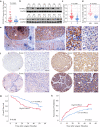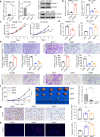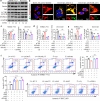STOML2 potentiates metastasis of hepatocellular carcinoma by promoting PINK1-mediated mitophagy and regulates sensitivity to lenvatinib
- PMID: 33446239
- PMCID: PMC7807703
- DOI: 10.1186/s13045-020-01029-3
STOML2 potentiates metastasis of hepatocellular carcinoma by promoting PINK1-mediated mitophagy and regulates sensitivity to lenvatinib
Abstract
Background: Dysregulation of both mitochondrial biogenesis and mitophagy is critical to sustain oncogenic signaling pathways. However, the mechanism of mitophagy in promoting hepatocellular carcinoma (HCC) progression remains poorly understood. In this study, we investigated the clinical significance and biological involvement of mitochondrial inner membrane protein STOML2 in HCC.
Methods: STOML2 was identified by gene expression profiles of HCC tissues and was measured in tissue microarray and cell lines. Gain/loss-of-function experiment was applied to study the biological function of STOML2 in HCC. Flow cytometry, Western blotting, laser confocal microscopy, transmission electron microscopy, and co-immunoprecipitation were used to detect and analyze mitophagy. ChIP and luciferase reporter assay were conducted to evaluate the relationship between STOML2 and HIF-1α. The sensitivity to lenvatinib was assessed in HCC both in vitro and in vivo.
Results: Increased expression of STOML2 was found in HCC compared with paired peritumoral tissues. It was more significant in HCC with metastasis and correlated with worse overall survival and higher probability of recurrence after hepatectomy. Upregulation of STOML2 accelerated HCC cells colony formation, migration and invasion. Mechanically, TCGA dataset-based analysis showed enrichment of autophagy-related pathways in STOML2 highly-expressed HCC. Next, STOML2 was demonstrated to interact and stabilize PINK1 under cellular stress, amplify PINK1-Parkin-mediated mitophagy and then promote HCC growth and metastasis. Most interestingly, HIF-1α was upregulated and transcriptionally increased STOML2 expression in HCC cells under the treatment of lenvatinib. Furthermore, higher sensitivity to lenvatinib was found in HCC cells when STOML2 was downregulated. Combination therapy with lenvatinib and mitophagy inhibitor hydroxychloroquine obtained best efficacy.
Conclusions: Our findings suggested that STOML2 could amplify mitophagy through interacting and stabilizing PINK1, which promote HCC metastasis and modulate the response of HCC to lenvatinib. Combinations of pharmacologic inhibitors that concurrently block both angiogenesis and mitophagy may serve as an effective treatment for HCC.
Keywords: Hepatocellular carcinoma (HCC); Lenvatinib; Mitophagy; PTEN-induced putative kinase 1 (PINK1); Stomatin-like protein 2 (STOML2).
Conflict of interest statement
There is no conflict of interest with regard to the submitted manuscript.
Figures







Similar articles
-
EVA1A reverses lenvatinib resistance in hepatocellular carcinoma through regulating PI3K/AKT/p53 signaling axis.Apoptosis. 2024 Aug;29(7-8):1161-1184. doi: 10.1007/s10495-024-01967-0. Epub 2024 May 14. Apoptosis. 2024. PMID: 38743191
-
FBXO32 ubiquitination of SUFU promotes progression and lenvatinib resistance in hepatocellular carcinoma via hedgehog signaling.Med Oncol. 2025 Mar 11;42(4):98. doi: 10.1007/s12032-025-02644-1. Med Oncol. 2025. PMID: 40067532
-
GPX2 inhibition enhances antitumor efficacy of lenvatinib via promoting immunogenic cell death in hepatocellular carcinoma.J Transl Med. 2025 Apr 18;23(1):456. doi: 10.1186/s12967-025-06468-5. J Transl Med. 2025. PMID: 40251668 Free PMC article.
-
Lenvatinib: a potential breakthrough in advanced hepatocellular carcinoma?Future Oncol. 2016 Feb;12(4):465-76. doi: 10.2217/fon.15.341. Epub 2016 Jan 20. Future Oncol. 2016. PMID: 26785762 Review.
-
Lenvatinib and its use in the treatment of unresectable hepatocellular carcinoma.Future Oncol. 2018 Aug;14(20):2021-2029. doi: 10.2217/fon-2017-0689. Epub 2018 May 22. Future Oncol. 2018. PMID: 29783903 Review.
Cited by
-
Aberrantly hypermethylated ARID1B is a novel biomarker and potential therapeutic target of colon adenocarcinoma.Front Genet. 2022 Oct 14;13:914354. doi: 10.3389/fgene.2022.914354. eCollection 2022. Front Genet. 2022. PMID: 36313455 Free PMC article.
-
Wnt/β-Catenin Signaling as a Driver of Hepatocellular Carcinoma Progression: An Emphasis on Molecular Pathways.J Hepatocell Carcinoma. 2021 Nov 25;8:1415-1444. doi: 10.2147/JHC.S336858. eCollection 2021. J Hepatocell Carcinoma. 2021. PMID: 34858888 Free PMC article. Review.
-
ABALON regulates mitophagy and 5-FU sensitivity in colorectal cancer via PINK1-Parkin pathway.Transl Cancer Res. 2024 Nov 30;13(11):6201-6218. doi: 10.21037/tcr-24-933. Epub 2024 Nov 27. Transl Cancer Res. 2024. PMID: 39697760 Free PMC article.
-
Identification of Causal Plasma Proteins in Hepatocellular Carcinoma via Two-Sample Mendelian Randomization and Integrative Transcriptomic‒Proteomic Analysis.Cancer Res Commun. 2025 Mar 1;5(3):433-443. doi: 10.1158/2767-9764.CRC-24-0553. Cancer Res Commun. 2025. PMID: 39991825 Free PMC article.
-
Chloroquine and Chemotherapeutic Compounds in Experimental Cancer Treatment.Int J Mol Sci. 2024 Jan 12;25(2):945. doi: 10.3390/ijms25020945. Int J Mol Sci. 2024. PMID: 38256019 Free PMC article. Review.
References
Publication types
MeSH terms
Substances
LinkOut - more resources
Full Text Sources
Other Literature Sources
Medical
Research Materials
Miscellaneous

